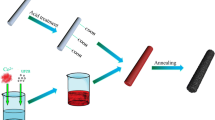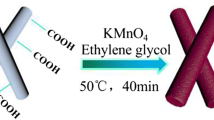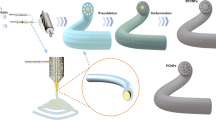Abstract
Carbon fibres have been extensively investigated for their promising potential as anodes or current collectors in next-generation integrated batteries. However, the exact reasons for the distinct lithium-ion battery (LIB) performance of different carbon fibres remain largely unknown. In this work, we explored the morphology-/microstructure-mediated lithiation mechanism in carbon fibre anodes and found that a pitch-based carbon fibre with the highest crystal-ordering degree exhibited higher cycling stability but lower reversible capacity and rate capability than a polyacrylonitrile-based carbon fibre (PAN) with the lowest crystal-ordering degree; a modified PAN carbon fibre with a slightly higher crystal ordering degree than PAN showed the highest cycling stability and rate capability. Such carbon-fibre-dependent lithiation is attributable to the distinct lithiation kinetics intrinsic to carbon fibres with different microstructures. This study reveals the morphology-/microstructure-dependent lithiation mechanism of carbon fibres and provides important insights into the interplay between their lithiation kinetics, microstructure and lithium storage performance. Carbon fibres’ adequate crystal degree, small diameter and high structural integrity collectively account for their superior electrochemical properties. This provides guidelines for the design of carbon fibre electrodes and other carbonaceous electrodes for use in next-generation LIBs.









Similar content being viewed by others
References
Liu LX, Weng QH, Lu XY, Sun XL, Zhang L, Schmidt OG (2017) Advances on Microsized On-Chip Lithium-Ion Batteries. Small 13:1701847
Wang YX, Liu B, Li QY, Cartmell S, Ferrara S, Deng ZQD, Xiao J (2015) Lithium and lithium ion batteries for applications in microelectronic devices: A review. J Power Sources 286:330–345
Zhang PP, Wang FX, Yu MH, Zhuang XD, Feng XL (2018) Two-dimensional materials for miniaturized energy storage devices: from individual devices to smart integrated systems. Chem Soc Rev 47:7426–7451
Zubi G, Dufo-Lopez R, Carvalho M, Pasaoglu G (2018) The lithium-ion battery: State of the art and future perspectives. Renew Sust Energ Rev 89:292–308
Asp LE, Greenhalgh ES (2014) Structural power composites. Compos Sci Technol 101:41–61
Asp LE, Johansson M, Lindbergh G, Xu J, Zenkert D (2019) Structural battery composites: a review. Funct Compos Struct 1:042001
Yu Y, Zhang B, Feng M, Qi G, Tian F, Feng Q, Yang J, Wang S (2017) Multifunctional structural lithium ion batteries based on carbon fiber reinforced plastic composites. Compos Sci Technol 147:62–70
Johannisson W, Ihrner N, Zenkert D, Johansson M, Carlstedt D, Asp LE, Sieland F (2018) Multifunctional performance of a carbon fiber UD lamina electrode for structural batteries. Compos Sci Technol 168:81–87
Xu JH, Geng ZY, Johansen M, Carlstedt D, Duan SH, Thiringer T, Liu F, Asp LE (2022) A multicell structural battery composite laminate. Ecomat 4:e12180
Zhou GM, Li F, Cheng HM (2014) Progress in flexible lithium batteries and future prospects. Energy Environ Sci 7:1307–1338
Liu B, Zhang J, Wang XF, Chen G, Chen D, Zhou CW, Shen GZ (2012) Hierarchical Three-Dimensional ZnCo2O4 Nanowire Arrays/Carbon Cloth Anodes for a Novel Class of High-Performance Flexible Lithium-Ion Batteries. Nano Lett 12:3005–3011
Zhang GH, Hou SC, Zhang H, Zeng W, Yan FL, Li CC, Duan HG (2015) High-Performance and Ultra-Stable Lithium-Ion Batteries Based on MOF-Derived ZnO@ZnO Quantum Dots/C Core-Shell Nanorod Arrays on a Carbon Cloth Anode. Adv Mater 27:2400–2405
Deng ZN, Jiang H, Hu YJ, Liu Y, Zhang L, Liu HL, Li CZ (2017) 3D Ordered Macroporous MoS2@C Nanostructure for Flexible Li-Ion Batteries. Adv Mater 29
Huang Y, Zhu MS, Huang Y, Pei ZX, Li HF, Wang ZF, Xue Q, Zhi CY (2016) Multifunctional Energy Storage and Conversion Devices. Adv Mater 28:8344–8364
Hagberg J, Maples HA, Alvim KSP, Xu J, Johannisson W, Bismarck A, Zenkert D, Lindbergh G (2018) Lithium iron phosphate coated carbon fiber electrodes for structural lithium ion batteries. Compos Sci Technol 162:235–243
Ren J, Zhang Y, Bai WY, Chen XL, Zhang ZT, Fang X, Weng W, Wang YG, Peng HS (2014) Elastic and Wearable Wire-Shaped Lithium-Ion Battery with High Electrochemical Performance. Angew Chem Int Ed 53:7864–7869
Hagberg J, Leijonmarck S, Lindbergh G (2016) High Precision Coulometry of Commercial PAN-Based Carbon Fibers as Electrodes in Structural Batteries. J Electrochem Soc 163:A1790–A1797
Lin HJ, Weng W, Ren J, Qiu LB, Zhang ZT, Chen PN, Chen XL, Deng J, Wang YG, Peng HS (2014) Twisted Aligned Carbon Nanotube/Silicon Composite Fiber Anode for Flexible Wire-Shaped Lithium-Ion Battery. Adv Mater 26:1217–1222
Schutzeichel MOH, Kletschkowski T, Linde P, Asp LE (2019) Experimental characterization of multifunctional polymer electrolyte coated carbon fibres. Funct Compos Struct 1:025001
Li X, Zeng SB, Li WT, Lin HJ, Zhong H, Zhu HB, Mai YH (2022) Stretchable hydrogel electrolyte films based on moisture Self-absorption for flexible Quasi-solid-state batteries. Chem. Eng. J. 439
Lee JE, Choi J, Lee DJ, Lee S, Chae HG (2022) Radial microstructure development of polyacrylonitrile (PAN)-based carbon fibers. Carbon 191:515–524
Li B, Guo J, Huang J, Xu H, Dong Z, Li X (2020) Impact of Microstructure on the Electrochemical Performance of Round-Shaped Pitch-Based Graphite Fibers. Materials 13
Wu H, Huang D, Ye C, Ouyang T, Zhu SP, Fan Z, Ye GM, Wu X, Shi K, Han F, Liu HB, Liu JS (2022) Engineering microstructure toward split-free mesophase pitch-based carbon fibers. J Mater Sci 57:2411–2423
Zuo TT, Wu XW, Yang CP, Yin YX, Ye H, Li NW, Guo YG (2017) Graphitized Carbon Fibers as Multifunctional 3D Current Collectors for High Areal Capacity Li Anodes. Adv Mater 29:1700389
Kjell MH, Jacques E, Zenkert D, Behm Mr, Lindbergh Gr (2011) PAN-Based Carbon Fiber Negative Electrodes for Structural Lithium-Ion Batteries. J. Electrochem. Soc. 158 A1455
Snyder JF, Wong EL, Hubbard CW (2009) Evaluation of Commercially Available Carbon Fibers, Fabrics, and Papers for Potential Use in Multifunctional Energy Storage Applications. J Electrochem Soc 156:A215
Sun Q, Li DP, Cheng J, Dai LN, Guo JG, Liang Z, Ci LJ (2019) Nitrogen-doped carbon derived from pre-oxidized pitch for surface dominated potassium-ion storage. Carbon 155:601–610
Liu G, Yang Y, Lu X, Qi F, Liang Y, Trukhanov A, Wu Y, Sun Z and Lu X Fully Active Bimetallic Phosphide Zn0.5Ge0.5P: A Novel High-Performance Anode for Na-Ion Batteries Coupled with Diglyme-Based Electrolyte. ACS Appl. Mater. Inter. 14(28): 31803–31813
Wang MY, Zhu YY, Zhang Y, Duan JY, Wang KK, Wang R, Sun GY, Wang CY (2021) Isotropic high softening point petroleum pitch-based carbon as anode for high-performance potassium-ion batteries. J. Power Sources 481
Liu W, Zhang K, Ma L, Ning RQ, Chen ZX, Li J, Yan YG, Shang TT, Lyu ZY, Li Z, Xie KY, Loh KP (2022) An ion sieving conjugated microporous thermoset ultrathin membrane for high-performance Li-S battery. Energy Storage Mater 49:1–10
Fredi G, Jeschke S, Boulaoued A, Wallenstein J, Rashidi M, Liu F, Harnden R, Zenkert D, Hagberg J, Lindbergh G, Johansson P, Stievano L, Asp LE (2018) Graphitic microstructure and performance of carbon fibre Li-ion structural battery electrodes. Multifunct Mater 1:015003
Kim BG, Kang DW, Park G, Park SH, Lee S-M, Choi JW (2021) Electrospun Li-confinable hollow carbon fibers for highly stable Li-metal batteries. Chem Eng J 422:130017
Liang Y, Chen Y, Ke X, Zhang Z, Wu W, Lin G, Zhou Z, Shi Z (2020) Coupling of triporosity and strong Au–Li interaction to enable dendrite-free lithium plating/stripping for long-life lithium metal anodes. J Mater Chem A 8:18094–18105
Qiao L, Zhang RH, Li YG, Xu R, Li Y, Li DW, Gao M, Xu GC, Wang M, Liang X, Zhang XS, Gu QQ, Gong HY, Liang K, Chen P, Kong BA (2022) Super-Assembled Hierarchical and Stable N-Doped Carbon Nanotube Nanoarrays for Dendrite-Free Lithium Metal Batteries. ACS Appl Energy Mater 5:815–824
Lytle JC, Wallace JM, Sassin MB, Barrow AJ, Long JW, Dysart JL, Renninger CH, Saunders MP, Brandell NL, Rolison DR (2011) The right kind of interior for multifunctional electrode architectures: carbon nanofoam papers with aperiodic submicrometre pore networks interconnected in 3D. Energy Environ Sci 4:1913–1925
Lim LY, Fan S, Hng HH, Toney MF (2015) Storage Capacity and Cycling Stability in Ge Anodes: Relationship of Anode Structure and Cycling Rate. Adv. Energy Mater. 5 91
Fu F, Yao Y, Wang H, Xu G-L, Amine K, Sun S-G, Shao M (2017) Structure dependent electrochemical performance of Li-rich layered oxides in lithium-ion batteries. Nano Energy 35:370–378
Jung H-G, Hassoun J, Park J-B, Sun Y-K, Scrosati B (2012) An improved high-performance lithium–air battery. Nat Chem 4:579–585
Balogun MS, Li C, Zeng Y, Yu M, Wu Q, Wu M, Lu X, Tong Y (2014) Titanium dioxide@titanium nitride nanowires on carbon cloth with remarkable rate capability for flexible lithium-ion batteries. J Power Sources 272:946–953
Liu T, Wang W, Yi M, Chen Q, Xu C, Cai D, Zhan H (2018) Metal-organic framework derived porous ternary ZnCo2O4 nanoplate arrays grown on carbon cloth as binder-free electrodes for lithium-ion batteries. Chem Eng J 354:454–462
Jacques E, Kjell MH, Zenkert D, Lindbergh G, Behm M (2013) Expansion of carbon fibres induced by lithium intercalation for structural electrode applications. Carbon 59:246–254
Yoon D-H, Marinaro M, Axmann P, Wohlfahrt-Mehrens M (2018) Communication—Quantitative Analysis of Consumption of Fluoroethylene Carbonate Additives on Silicon Alloy Anodes. J Electrochem Soc 165:A2467–A2469
Petibon R, Chevrier VL, Aiken CP, Hall DS, Hyatt SR, Shunmugasundaram R, Dahn JR (2016) Studies of the Capacity Fade Mechanisms of LiCoO2/Si-Alloy: Graphite Cells. J Electrochem Soc 163:A1146–A1156
Acknowledgements
This work was financially supported by Tongji University (Project No. 13302150046 and 13302350056), the National Natural Science Foundation of China (No. 32071337). This work is also sponsored by the Young Elite Scientists Sponsorship Program of the Chinese Association of Science and Technology (2021QNRC001) and Shanghai Pujiang Program (20PJ1402600).
Funding
This work was financially supported by the Tongji University (project nos. 13302150046 and 13302350056) and the National Natural Science Foundation of China (no. 32071337). This work is also sponsored by the Young Elite Scientists Sponsorship Program of the Chinese Association of Science and
Author information
Authors and Affiliations
Additional information
Publisher's Note
Springer Nature remains neutral with regard to jurisdictional claims in published maps and institutional affiliations.
Supplementary Information
Below is the link to the electronic supplementary material.
Rights and permissions
Springer Nature or its licensor (e.g. a society or other partner) holds exclusive rights to this article under a publishing agreement with the author(s) or other rightsholder(s); author self-archiving of the accepted manuscript version of this article is solely governed by the terms of such publishing agreement and applicable law.
About this article
Cite this article
Fu, Y., Gan, Q. Experimental and analytical investigation of the potential of carbon fibres for use in multifunctional batteries. J Solid State Electrochem 27, 345–355 (2023). https://doi.org/10.1007/s10008-022-05332-6
Received:
Revised:
Accepted:
Published:
Issue Date:
DOI: https://doi.org/10.1007/s10008-022-05332-6




